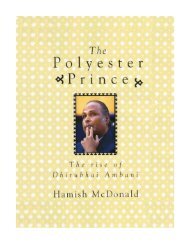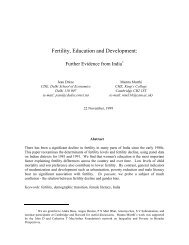The-Polyester-Prince
The-Polyester-Prince
The-Polyester-Prince
- No tags were found...
You also want an ePaper? Increase the reach of your titles
YUMPU automatically turns print PDFs into web optimized ePapers that Google loves.
GURU OF THE EQUITY CULTIndira Gandhi’s return to power opened a golden period for Dhirubhai Ambani. In1979, his company barely made it to the list of India’s 50 biggest companies,measured by annual sales, profits or assets. By 1984, Reliance was in the largestfive. Dhirubhai himself had become one of the most talked and written about personsin India, gaining a personal following more like that of a sports or entertainment starthan a businessman. It was also the period when Dhirubhai made the most rapidpart of his transition, in the bitter words of a senior non-Congress politician in 1996,‘..from supplicant-the most abject kind of supplicant-to influencer and then tocontroller of Indian politics’.Although it was not immediately obvious, Indira’s three years in political exile hadreinforced a change in her thinking about state intervention in the economy. In largepart due to the influence of her son Sanjay, who was to die in 1980 when the lightaircraft he was piloting crashed during some acrobatics over New Delhi, she was lesstrustful of bureaucratic direction, and more inclined to give the private sector itshead.Indian business leaders were also calling for a drastic relaxation of the licencecontrols on capacity expansion and diversification vested in the Monopolies andRestrictive Trade Practices Commission. One was the head of the extensive Tatagroup, J. R. D. Tata, who along with others in the 1940s had willingly laid their headson the block of state planning. By 1981, Tata was calling on New Delhi to unfetterthe big business houses. <strong>The</strong> intellectual tide had turned in favour of economicliberalisation, though it would not be until a decade later that anything more thantentative policy change was attempted.In Indira’s case, the disillusionment on the economic side was matched by a deepercynicism in politics. Her second spell as prime minister was marked by callousmanipulations such as the sponsorship of Sikh extremists in the Punjab, and byunapologetic extraction of political funds from businessmen expecting clearancesfrom New Delhi. Dhirubhai’s cultivation of Indira and other Congress figures duringthe Janata period certainly paid off.In October 1980, Reliance received one of three licenses given by the governmentfor manufacture of polyester filament yarn, with the location stipulated as the‘backward’ area of Patalganga in the hills of Maharashtra inland from Bombay. In afield of 43 contestants for the licences, Reliance beat many larger and longerestablishedbusiness houses including Birla. Its licensed capacity of 10 000 tonnes ayear was by far the largest (Orkay Silk Mills and J K Synthetics were each cleared for6000 tonnes a year), and at the time close to India’s entire existing polyester fibreoutput.Together with the Du Pont representative Suresh Kothary, Dhirubhai and his eldestson Mukesh had already been to the headquarters of Du Pont at Wilmington,Delaware, and persuaded the American chemicals giant to sell its technology,including a polymerisation process not previously transferred outside the UnitedStates.<strong>The</strong> deal arranged through a New York-based firm called Chemtex Inc saw Reliancemake a US$26.7 million order for its first PFY plant. Making polyester is a highlycomplicated chemical process, involving the reaction of one petrochemical




